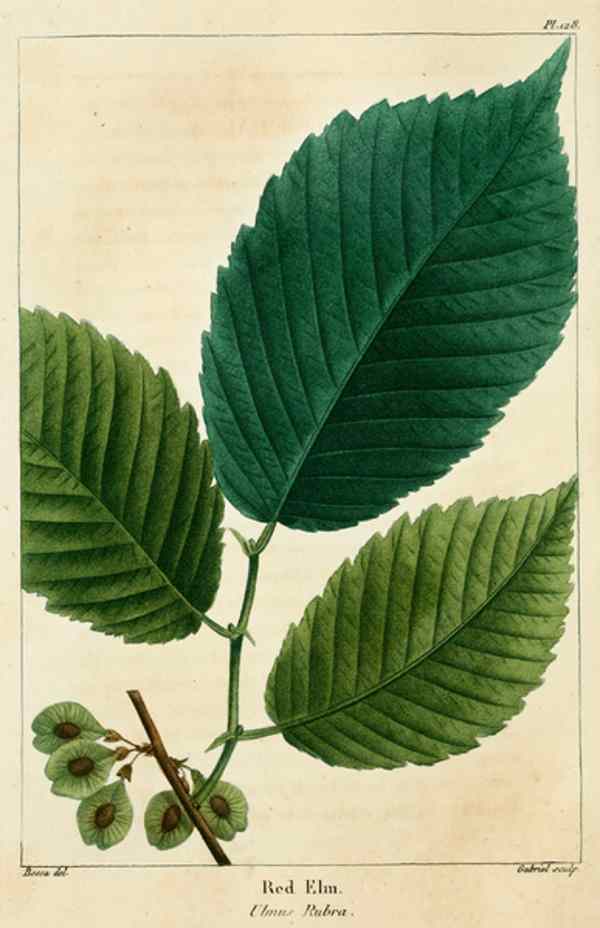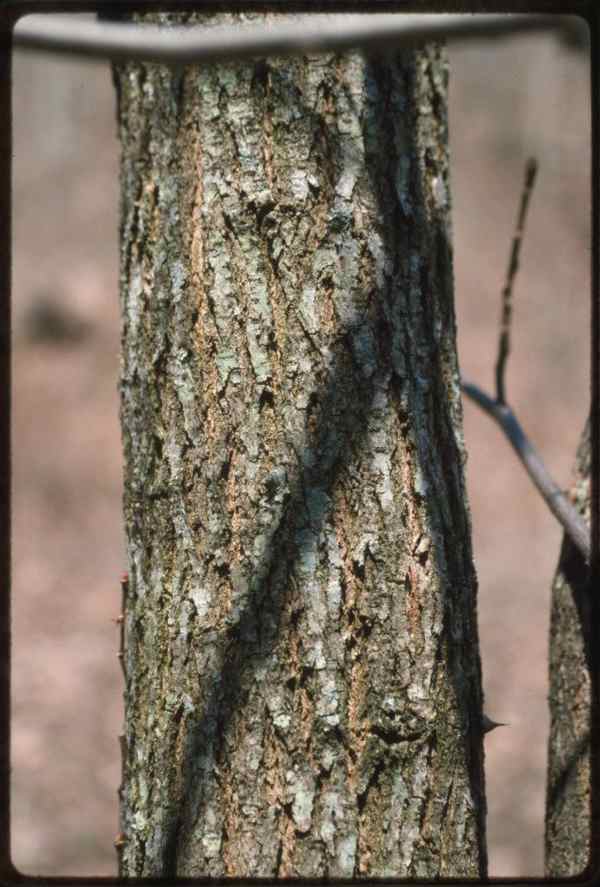Medicinal Uses Of Slippery Elm
Slippery elm (Ulmus rubra) (formally Ulmus fulva)is a tree in the elm family. Slippery Elm is native to eastern North America from southern Quebec to northern Florida and westward to Texas. The inner bark has long been used in traditional Native American medicine to gastrointestinal ailments.
However, before you learn how to use it, you must first know how to identify it. Slippery Elm has an alternate leaf structure. Most trees have leaves that or opposite meaning two leaves directly across from each other or altenate meaning one on the left then another on the right continueing in an alternating manner.
The leaves are also simple which means they are not compound leaves made of leaflets which can look like individual leaves. Close examination of a live green leaf will reveal the upper leaf surface is very rough with stiff hairs while the lower leaf surface paler (common trait of leaves), with soft hairs.
Slippery elm leave or ovate to oblong in shape (see leaf pic) and full size leaves are usually 4 to 6 inches long and not quite as wide as they are long. The edge of the leaf is made up of teeth that are doubly serrated and notice the base of the leaf is sort of lopsided. The technical term for this would be inequilateral aka larger on one side than the other.
It is important to be able to tell Slippery Elm from the more common American elm. In slippery elm the top of the leaf surface has a sandpapery feel whereas the American elm is smoother. Also American elm has a fluted base much more so than the Slippery Elm. A fluted base means that the trunk of the tree at the ground level isn't simply round, but is very irregular with section that spread out much further normal. Another way to say it is the cross-section at the ground will look more like a star than a circle.
The twigs are thicker than those of an American elm. Learning this will come with time and observation of each species. The bark is reddish brown with a less diamond-shape in the pattern than American Elm.

Now that that is out of the way we can move on to the medicinal aspects of the Slippery Elm and oh boy they are something special. So special in fact that unlike a lot of medicinal plants this one is commonly sold even today as a medicine.
Slippery Elm contains in its inner bark a fiber that traps and absorbs water forming a gel. This gel has a high calcium content and provides short-term relief of pain and inflammation and can ac as an antacid.
Slippery Elm is applied topically for cuts and burns.
Orally for the following.
Acid reflux
Cystitis
Inflammatory bowel disease
Irritable bowel syndrome (IBS)
Constipation
Mouth ulcers
Sore Throat
Diarrhea
Urinary inflammation
Note that for some of these uses such as sore throat or acid reflux Slippery Elm is used only to treat the symptoms and is not used to cure you from the cause of those symptoms.
Also of note is that people with IBS-C get much more relief than with IBS-D.
If you have ulcerative colitis Slippery Elm might help. Although it has been shown to help in a lab no research has ever been done to my knowledge to show that it helps when taken orally. So you can try but it might do nothing.
Keep in mind that medicines can have side effects and there is the potential for side effects such as nausea or other side effects and can potentially reduce the effectiveness of other drugs by limiting their absorption.
This article on Slippery Elm is intended for societal breakdown when you will not have access to pharmaceutical drugs. So if you are already taking medications you should consult with your doctor before trying Slippery Elm on your own.
Out of an abundance of caution avoid Slippery Elm when pregnant or trying to get pregnant. One of the unproven uses of Slippery Elm historically was to induce abortions.
How to Use Slippery Elm
Cut away the inner bark of the slippery elm and then for sore throat you can chew the inner bark right away. Or for all uses you can dry the inner bark and grind it into a fine powder. When it comes time to use the powder mix the powder with water.
The harvesting of the Slippery Elm should not be done currently. Slippery Elm is being severely hurt by Dutch Elm disease. So save its use for after modern medicine is no longer available.
However, before you learn how to use it, you must first know how to identify it. Slippery Elm has an alternate leaf structure. Most trees have leaves that or opposite meaning two leaves directly across from each other or altenate meaning one on the left then another on the right continueing in an alternating manner.
The leaves are also simple which means they are not compound leaves made of leaflets which can look like individual leaves. Close examination of a live green leaf will reveal the upper leaf surface is very rough with stiff hairs while the lower leaf surface paler (common trait of leaves), with soft hairs.
Slippery elm leave or ovate to oblong in shape (see leaf pic) and full size leaves are usually 4 to 6 inches long and not quite as wide as they are long. The edge of the leaf is made up of teeth that are doubly serrated and notice the base of the leaf is sort of lopsided. The technical term for this would be inequilateral aka larger on one side than the other.
It is important to be able to tell Slippery Elm from the more common American elm. In slippery elm the top of the leaf surface has a sandpapery feel whereas the American elm is smoother. Also American elm has a fluted base much more so than the Slippery Elm. A fluted base means that the trunk of the tree at the ground level isn't simply round, but is very irregular with section that spread out much further normal. Another way to say it is the cross-section at the ground will look more like a star than a circle.
The twigs are thicker than those of an American elm. Learning this will come with time and observation of each species. The bark is reddish brown with a less diamond-shape in the pattern than American Elm.


Now that that is out of the way we can move on to the medicinal aspects of the Slippery Elm and oh boy they are something special. So special in fact that unlike a lot of medicinal plants this one is commonly sold even today as a medicine.
Slippery Elm contains in its inner bark a fiber that traps and absorbs water forming a gel. This gel has a high calcium content and provides short-term relief of pain and inflammation and can ac as an antacid.
Slippery Elm is applied topically for cuts and burns.
Orally for the following.
Acid reflux
Cystitis
Inflammatory bowel disease
Irritable bowel syndrome (IBS)
Constipation
Mouth ulcers
Sore Throat
Diarrhea
Urinary inflammation
Note that for some of these uses such as sore throat or acid reflux Slippery Elm is used only to treat the symptoms and is not used to cure you from the cause of those symptoms.
Also of note is that people with IBS-C get much more relief than with IBS-D.
If you have ulcerative colitis Slippery Elm might help. Although it has been shown to help in a lab no research has ever been done to my knowledge to show that it helps when taken orally. So you can try but it might do nothing.
Keep in mind that medicines can have side effects and there is the potential for side effects such as nausea or other side effects and can potentially reduce the effectiveness of other drugs by limiting their absorption.
This article on Slippery Elm is intended for societal breakdown when you will not have access to pharmaceutical drugs. So if you are already taking medications you should consult with your doctor before trying Slippery Elm on your own.
Out of an abundance of caution avoid Slippery Elm when pregnant or trying to get pregnant. One of the unproven uses of Slippery Elm historically was to induce abortions.
How to Use Slippery Elm
Cut away the inner bark of the slippery elm and then for sore throat you can chew the inner bark right away. Or for all uses you can dry the inner bark and grind it into a fine powder. When it comes time to use the powder mix the powder with water.
The harvesting of the Slippery Elm should not be done currently. Slippery Elm is being severely hurt by Dutch Elm disease. So save its use for after modern medicine is no longer available.
